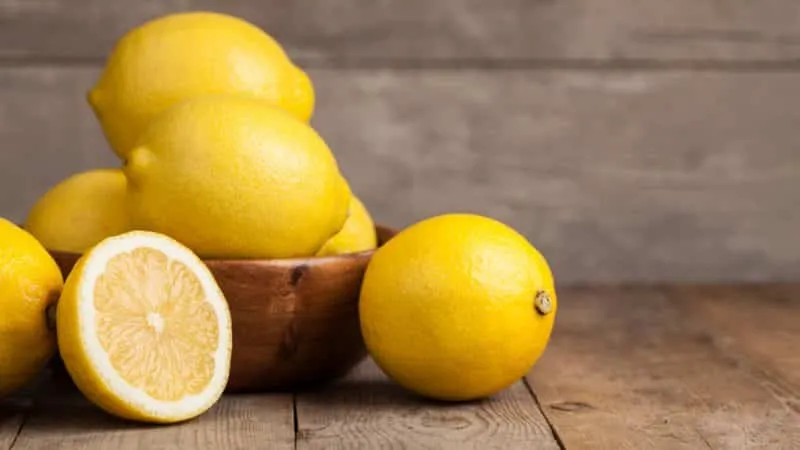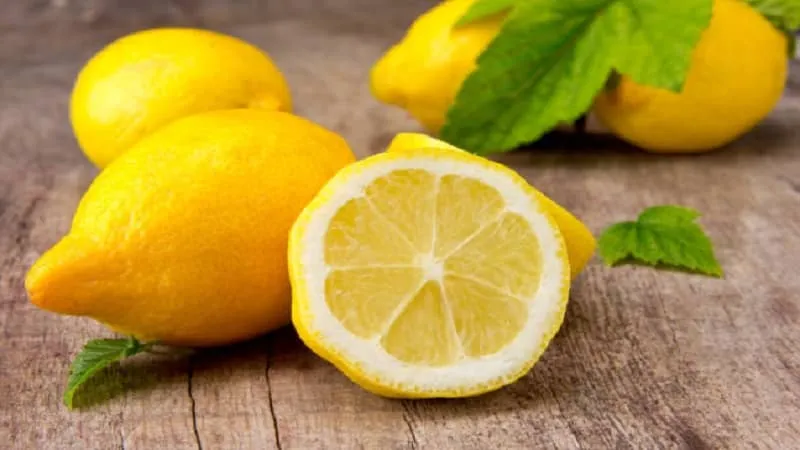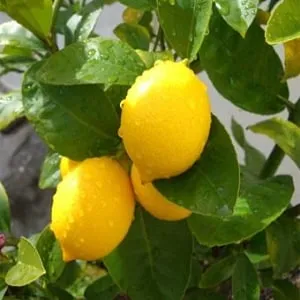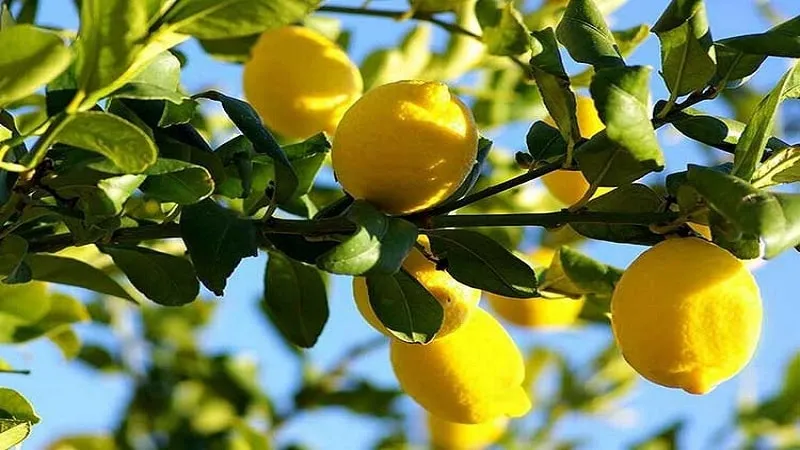The word "lemon" refers to both lemon trees and their fruits. This member of the Citrus family originates from India. Bright yellow fruits with sour pulp are valued worldwide for their high content of vitamin C, essential oils, potassium, calcium, and magnesium. The distinctive citrus aroma and taste come from D-limonene. In this article, we’ll explore everything about lemons: their origin, distribution, botanical features, and chemical composition.
Table of contents
What is a lemon?

Lemon (lat. Citrus limon) is the name of a fruit-bearing tree of the Citrus genus (Citrus), Rutaceae family (Rutacea), and its fruits.
The name "lemon" comes from the Malay word "lemo." In India, lemon fruits are called "nimu," while in China, they are known as "limung."
The lemon’s origin traces back to India and the tropical islands of the Pacific Ocean. Botanists believe it is a hybrid of citron and bitter orange, resulting from cross-pollination between the two plants.
The first mentions of lemons appeared around 2000 BC in historical records from India and Pakistan. By the 12th century, lemons had reached the Middle East and North Africa thanks to Arab traders. Crusaders later introduced them to Spain and Italy.
Note. Mexico and India are the world leaders in lemon production, with an annual output of 14 million tons, accounting for 32% of the global harvest.
Lemons have been cultivated in Europe for centuries. In the 18th century, lemon trees became popular in orangeries across France, Germany, and the Netherlands. The fruit was no longer considered an exotic rarity but a staple in culinary and medicinal practices.
Some historians believe lemons were introduced to Northern Europe through trade with Mediterranean countries. By the 1700s, lemon cultivation had spread among the aristocracy, who grew them in greenhouses as a symbol of prestige.
In the mid-19th century, the renowned "Amalfi" lemon variety emerged in Italy, named after the coastal region where it was first cultivated. This variety became famous for its fragrant peel and balanced acidity, making it a favorite among European chefs.
Botanical description of the plant
Where do lemons grow? The fruits develop on lemon trees. The fruit measures 6-9 cm in length and 4-6 cm in diameter. Its shape is ovoid or oval, tapering at both ends. The rind is light yellow, bumpy, rich in essential oils, and difficult to separate from the pulp.
Beneath the rind, there are 8-10 spongy segments. The pulp consists of juice-filled vesicles in a greenish-yellow hue.
The seeds are ovoid, yellow-green or white, with a single embryo.
The first fruits appear 6-7 years after planting. The ripening season is autumn.
Below is a photo of a sliced lemon.

From a botanical perspective, is a lemon a vegetable, berry, or fruit? Many struggle with this question. We commonly refer to cucumbers as vegetables and bananas, apples, and citrus fruits as fruits. Scientific literature describes lemons as hesperidia — multi-chambered, multi-seeded fruits structurally similar to berries. The outer yellow layer covers a spongy endocarp and albedo, traits shared with mandarins, oranges, pomelos, and grapefruits.
Tree description
Now, let’s examine the lemon tree itself.
This medium-sized evergreen tree reaches 5-8 m in height. The crown is spreading or pyramidal. The average lifespan is 35 years, with a maximum of 45 years.
The bark is gray, with slight cracks on mature branches. Young branches are reddish-purple with smooth bark and may have thorns.
The leaves are leathery, green, 10-15 cm long, and 5-8 cm wide. The surface is glossy on top and light green, matte underneath. The leaf margin is entire, with veins and small reservoirs of essential oil.
The shape is broadly oval or oblong-ovate, pointed at both ends. The structure is compound. Petioles are short (1-1.8 cm), winged or wingless, with a distinct joint at the base. Leaves shed every three years, separating from the petiole.
Flowers are solitary or paired, axillary. They measure 2-3 cm. The corolla has five petals. The petals are white or cream, sometimes tinged with pink or purple, curved, and emit a delicate fragrance. Blooming occurs from late April to early May.
Where lemons grow
Wild lemon trees no longer exist. Cultivation is widespread in subtropical regions, the Mediterranean, and parts of the Middle East. The plant thrives in soil with a pH of 5.5-6.5 and in areas with cool sea air. Ideal conditions are found in Italy (especially Sicily), Spain, Greece, Lebanon, Turkey, and Cyprus.
In Sicily, a unique cultivation technique has been used for over 70 years, enabling two harvests per season. Farmers induce a 60-day drought in summer, then apply nitrogen fertilizers and resume irrigation to trigger prolonged flowering. This results in fruit production from September to February. This method is exclusive to Sicily’s climate and hasn’t been successfully replicated elsewhere.
In Southern Europe, lemons are grown in open fields with protective measures against frost, such as trench planting.
Note. During his voyages, Captain James Cook carried lemons to prevent scurvy among his crew. In 1795, Britain mandated a daily ration of lemon juice for sailors.
Chemical composition of fresh lemons
The table below details the chemical composition of lemons (per 100 g).
| Nutrient | Amount | Daily Value |
| Vitamin A | 2 µg | 900 µg |
| Beta-carotene | 0.01 mg | 5 mg |
| Vitamin B1 | 0.04 mg | 1.5 mg |
| Vitamin B2 | 0.02 mg | 1.8 mg |
| Vitamin B4 | 5.1 mg | 500 mg |
| Vitamin B5 | 0.2 mg | 5 mg |
| Vitamin B6 | 0.06 mg | 2 mg |
| Vitamin B9 | 9 µg | 400 µg |
| Vitamin C | 40 mg | 90 mg |
| Vitamin E | 0.2 mg | 15 mg |
| Vitamin PP | 0.2 mg | 20 mg |
| Niacin | 0.1 mg | — |
| Potassium | 163 mg | 2500 mg |
| Calcium | 40 mg | 1000 mg |
| Silicon | 2 mg | 30 mg |
| Magnesium | 12 mg | 400 mg |
| Sodium | 11 mg | 1300 mg |
| Sulfur | 10 mg | 1000 mg |
| Phosphorus | 22 mg | 800 mg |
| Chlorine | 5 mg | 2300 mg |
| Aluminium | 44.6 µg | — |
| Boron | 175 µg | — |
| Vanadium | 4 µg | — |
| Iron | 0.6 mg | 18 mg |
| Iodine | 0.1 µg | 150 µg |
| Cobalt | 1 µg | 10 µg |
| Lithium | 10.3 µg | — |
| Manganese | 0.04 mg | 2 mg |
| Copper | 240 µg | 1000 µg |
| Molybdenum | 1 µg | 70 µg |
| Nickel | 0.9 µg | — |
| Rubidium | 5.1 µg | — |
| Selenium | 0.4 µg | 55 µg |
| Strontium | 0.05 µg | — |
| Fluorine | 10 µg | 4000 µg |
| Chromium | 0.2 µg | 50 µg |
| Zinc | 0.125 mg | 12 mg |
| Zirconium | 0.03 µg | — |
| Sucrose | 1 g | — |
| Fructose | 1 g | — |
| Saturated fatty acids | 0.039 g | 18.7 g |
| Omega-3 | 0.026 g | 0.9-3.7 g |
| Omega-6 | 0.063 g | 4.7-16.8 g |
Nutritional value per 100 g of lemon:
- Calories — 34 kcal;
- Protein — 0.9 g;
- Fat — 0.1 g;
- Carbohydrates — 3 g;
- Fiber — 2 g;
- Water — 88 g.
Conclusion
Botanists classify lemons as berry-like fruits. The tree’s maximum lifespan is 45 years, with fruiting beginning 6-7 years after planting. Sicily’s unique cultivation method allows for autumn-to-winter harvests.
Lemons are citrus fruits with a rich chemical profile and low calorie count, offering numerous health benefits. They thrive in subtropical climates, particularly in Mediterranean countries. In Southern Europe, lemons are grown in open fields with protective measures against cold weather. The "Amalfi" lemon and its variants are also popular for home cultivation.







